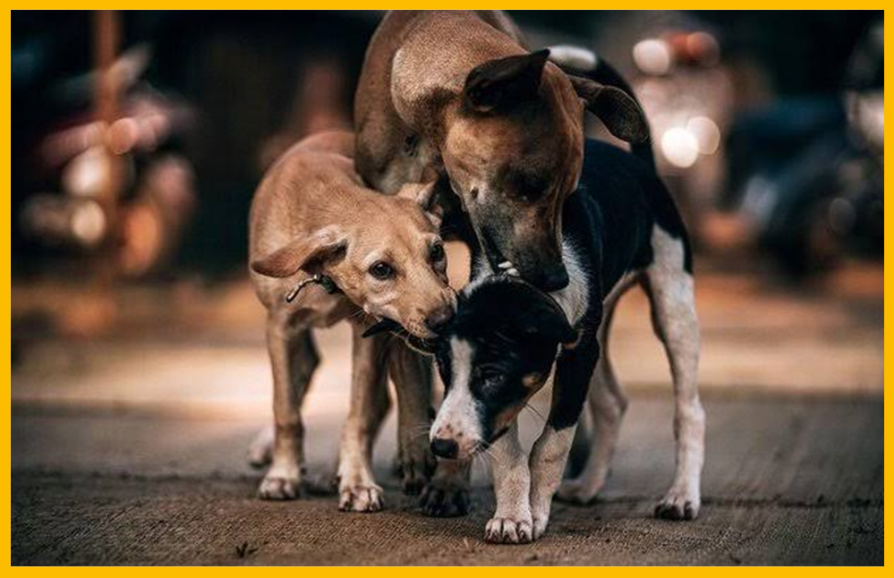How to befriend a stray dog
- December 9th 2019

Stray dogs are in as much need of love as household pets – more so, perhaps, because they get short supply of it. Most dog lovers know a stray dog (or a pack of them) that they’d love to help or befriend but are often baffled about how to go about it. How do you approach a stray?
Here are some Pet Project tips to help you help your neighbourhood dog.
Be calm but cautious
Remember, stray dogs can be wild and they often haven’t had great experiences with humans. Observe the dog’s behaviour. If they seem aggressive, don’t approach. If they’re scared or worried, you can try and alleviate some of that worry with the steps below but if that doesn’t work, back off. Don’t push them. You can always try again later when they seem in a better mood.
Avoid eye contact and move slowly
As you approach the stray, avoid prolonged eye contact. Dogs can see this as a sign of aggression and they will immediately mark you as a threat. Instead, look to the side of their face as you approach. Walk slowly; you don’t want to startle the dog.
Hold out your hand
If the dog doesn’t seem to be fazed by your approach, stop a few feet away from them and hold out your hand. Don’t go too close; you don’t want to overwhelm them by crowding their personal space. When you hold out your hand, make sure the palm is facing down. That’s it. Now wait for the dog to come sniff your hand. If they do, it means they’re curious and open to interacting with you. It’s important that you give them this option of engaging or simply walking away.
Crouching
This isn’t necessary, but it is recommended that you crouch when you hold out your hand. This allows you to be more or less the same height as the dog, which can be less intimidating to them. Make sure you don’t go to your hands and knees though, as you should be able to rise and leave quickly if the dog turns worried or aggressive.
Getting their attention
If you want to get
the stray dog’s attention, try softly clicking your tongue against your teeth
or calling out in a soothing and friendly voice. Never shout. Never startle the
stray, as that can lead to them becoming instantly aggressive. Always keep your
manner light and friendly, and make sure you radiate confidence.
Petting
If the dog approaches you to sniff your fingers, and they seem curious and friendly, pet them. Do so carefully and gently. Make sure that the dog can always see your hand, so don’t pet them from the back. It’s always best to start with the head, where they can see your palm, before moving to their back.
Most dogs like petting but keep an eye on the dog’s body language. If they seem skittish or if they growl, stop. You can always try again once you’ve found a way into their hearts.
A way to a stray’s heart
It’s food. That’s right – if you feed them, they’ll probably love you. With more aggressive strays, make sure you feed them from a distance, at least until they learn to trust you and see you as the food bearer. Feeding them on a consistent basis is the most likely method to earn a stray dog’s loyalty.
What to keep in mind about befriending a stray
· When playing with stray dogs, remember that it is not a sign of aggression if they take your hand in their mouth. Dogs do this when they’re playing; usually their teeth will just rest against your skin. Sometimes they can grip hard enough to break skin, but this isn’t done in violence. It’s love. Don’t panic or react negatively, as that may scare the dog.
· When a dog is aggressive or worried, their tail may stay straight up and their gums may be showing. They may also growl. When a dog is scared, their tail is usually between their legs and they will make themselves as small as possible. A friendly dog will wag its tail enthusiastically and approach in curiosity and for petting. These are good signs to see if a stray is happy at your approach.
· Stray dogs differ from place to place. Dogs in cities tend to be more desensitised to sound and human presence, and can be calmer than dogs in more remote areas, who are used to knowing the humans in their territory.
· Dogs are territorial by nature. They tend to get more aggressive at night, where the sound of the threat is clearer and they can’t see as well. Keep this in mind when trying to befriend a stray dog; they may be more wary of your advances during the night.
· Before approaching a stray,
always check for signs of rabies. A rabid dog is more prone to anxiousness and
restlessness; they are also more aggressive. They will constantly chew or lick
the place where they were bitten. Dogs with a certain type of rabies will have
a frothing mouth and will be scared of water. They may react aggressively to
any form of stimuli.
Once you have a stray’s love, you’ll have it forever. These beloved dogs also need their share of care and petting, so don’t be afraid to befriend a stray in your colony that may need a bit of attention.
